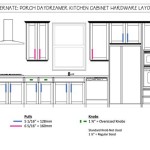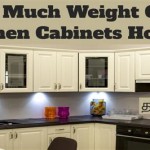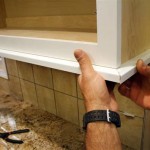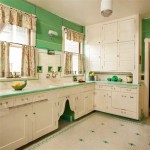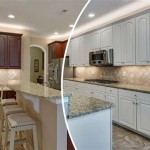Kitchen Cabinets and Countertops: A Guide to Timeless Design and Practical Functionality
Designing or renovating a kitchen involves careful consideration of numerous factors, with kitchen cabinets and countertops playing pivotal roles. These elements not only define the aesthetic appeal of the space but also significantly influence its functionality and overall value. Understanding the various options available, along with their respective benefits and drawbacks, is crucial for making informed decisions that align with individual needs and preferences.
The selection process should encompass a holistic approach, factoring in the kitchen's layout, the intended style, the available budget, and the anticipated level of usage. Compromising on quality or neglecting to consider long-term maintenance can lead to costly repairs and dissatisfaction in the future. This article delves into key considerations for cabinets and countertops, providing comprehensive guidance to navigate this critical aspect of kitchen design.
Cabinetry Styles and Materials
Kitchen cabinets are arguably the most visually prominent feature of the room, establishing the overall style and impacting the storage capacity. The style of cabinetry can range from traditional and ornate to sleek and modern, with numerous variations in between. The choice of material directly affects the cabinets' durability, appearance, and cost. Understanding the different types of cabinets and materials is essential for achieving the desired aesthetic and ensuring long-term performance.
Stock Cabinets: These are pre-fabricated cabinets available in standard sizes and limited styles. They are the most affordable option and offer the quickest turnaround time. However, the limited customization can present challenges in adapting to unique kitchen layouts.
Semi-Custom Cabinets: A middle ground between stock and custom, semi-custom cabinets offer a wider range of sizes, finishes, and door styles. They allow for modifications to standard sizes, providing more flexibility in design without the high cost of fully custom cabinets.
Custom Cabinets: These are built to order, offering complete design flexibility. Custom cabinets allow for incorporating specific dimensions, unique features, and personalized details. While the most expensive option, they provide the best fit for unconventional spaces and cater to individual preferences.
Cabinet Materials: The choice of material influences both the aesthetic and durability of the cabinets. Common materials include:
Solid Wood: Offers a classic and timeless look, known for its strength and beauty. Popular wood species include maple, oak, cherry, and walnut. Solid wood is susceptible to moisture damage and can expand or contract with changes in humidity.
Plywood: An engineered wood product made from layers of wood veneer glued together. It is more stable than solid wood and less prone to warping. Plywood is often used for cabinet boxes and interiors.
Medium-Density Fiberboard (MDF): Another engineered wood product made from wood fibers and resin. MDF is smooth, dense, and resistant to warping, making it a suitable option for painted cabinet doors and drawer fronts. However, it is less resistant to moisture than plywood or solid wood.
Particleboard: An inexpensive engineered wood product made from wood chips and resin. Particleboard is less dense and durable than plywood or MDF and is often used for cabinet interiors and shelving. It is highly susceptible to moisture damage.
Laminate: A synthetic material bonded to a substrate, such as particleboard or fiberboard. Laminate is durable, easy to clean, and available in a wide range of colors and patterns. It is a cost-effective option for cabinet surfaces.
Cabinet door styles also contribute significantly to the overall aesthetic. Popular styles include Shaker, flat-panel, raised-panel, and glass-front cabinets. Shaker cabinets, characterized by their simple, clean lines, are a versatile option that complements both traditional and modern designs. Flat-panel cabinets offer a sleek and minimalist look, while raised-panel cabinets provide a more ornate and traditional appearance. Glass-front cabinets can add visual interest and showcase decorative items.
Countertop Materials: Durability, Aesthetics, and Cost
Kitchen countertops are subjected to daily wear and tear, making material selection a critical consideration. The ideal countertop material should be durable, stain-resistant, heat-resistant, and easy to clean. In addition to functionality, the countertop material also contributes significantly to the overall aesthetic of the kitchen. The cost of different materials varies widely, requiring careful budgeting and prioritization.
Granite: A natural stone known for its durability, heat resistance, and unique patterns. Granite is a popular choice for high-end kitchens, offering a timeless and luxurious look. It requires sealing to prevent staining and can be relatively expensive.
Quartz: An engineered stone made from quartz crystals and resin. Quartz is non-porous, stain-resistant, and requires minimal maintenance. It is available in a wide range of colors and patterns, offering a consistent and uniform appearance. Quartz is generally more expensive than granite.
Marble: A natural stone prized for its elegant veining and luxurious appearance. Marble is softer and more porous than granite and quartz, making it more susceptible to staining and scratching. It requires regular sealing and careful maintenance. Marble is often used in kitchens where aesthetics are prioritized over durability.
Solid Surface: A synthetic material made from acrylic or polyester resins and mineral fillers. Solid surface countertops are non-porous, stain-resistant, and seamless. They are available in a wide range of colors and patterns and can be molded into various shapes and sizes. Solid surface countertops are a mid-range option in terms of cost and durability.
Laminate: A cost-effective option made from layers of paper and resin bonded to a substrate. Laminate countertops are available in a wide range of colors and patterns, including realistic stone and wood имитации. They are relatively durable and easy to clean, but they are susceptible to scratching and heat damage.
Butcher Block: A countertop made from strips of wood glued together. Butcher block countertops offer a warm and natural look. They are durable and can be refinished if scratched or damaged. Butcher block requires regular oiling to prevent drying and cracking. It is a popular choice for kitchen islands and prep areas.
Concrete: A versatile material that can be customized to create unique and contemporary countertops. Concrete countertops can be stained, polished, and sealed to achieve a variety of finishes. They are durable and heat-resistant but can be prone to cracking and staining if not properly sealed.
In addition to the material, the edge profile of the countertop also contributes to the overall aesthetic. Common edge profiles include bullnose, eased, beveled, and ogee. The choice of edge profile depends on the desired style and the thickness of the countertop material.
Planning and Installation Considerations
Proper planning and installation are crucial for achieving a successful kitchen renovation. Careful measurement of the kitchen space, consideration of existing plumbing and electrical systems, and adherence to building codes are essential for ensuring a smooth and efficient installation process. Hiring experienced professionals for both cabinet and countertop installation can prevent costly mistakes and ensure a high-quality finished product.
Layout and Design: The kitchen layout should be optimized for functionality and efficiency. The placement of cabinets, appliances, and countertops should follow the principles of the work triangle, which aims to minimize walking distances between the sink, refrigerator, and stove. Consider the storage needs and allocate sufficient space for dishes, cookware, and pantry items.
Measurement and Ordering: Accurate measurements are essential for ordering cabinets and countertops. Double-check all dimensions and consult with a professional designer or installer to ensure a proper fit. Consider the thickness of the countertop material and the overhang required for the sink and appliances.
Installation: Cabinet installation involves securing the cabinets to the walls and floor, ensuring that they are level and plumb. Countertop installation involves cutting the material to size, fitting it to the cabinets, and sealing the seams. Proper installation techniques are crucial for preventing leaks and ensuring the longevity of the countertops.
Plumbing and Electrical: Coordinate with plumbers and electricians to ensure that all plumbing and electrical connections are properly installed before and after cabinet and countertop installation. Ensure that the sink, faucet, dishwasher, and garbage disposal are properly connected.
Budgeting: Kitchen renovations can be expensive, so it is important to establish a realistic budget and stick to it. Obtain quotes from multiple contractors and suppliers to compare prices and services. Prioritize the most important features and materials and make concessions where necessary.
Maintenance: Regular cleaning and maintenance are essential for preserving the appearance and extending the life of kitchen cabinets and countertops. Wipe up spills immediately and avoid using harsh chemicals that can damage the surfaces. Follow the manufacturer's recommendations for cleaning and sealing.

Kitchen Countertop Ideas The Home Depot

Granite Kitchen Countertops Pictures And Ideas

5 White Kitchen Cabinet Ideas For Your Norfolk Bath

Countertop Ideas For Gray Kitchen Cabinets

15 Kitchen Countertop Ideas With White Cabinets Granite Types Of Countertops

Kitchen Countertop Ideas The Home Depot

23 Stylish Kitchen Countertop Ideas

15 Best Kitchen Countertop Ideas Granite Countertops And More

10 Timeless Kitchen Design Tips Ideas Kitchens

500 Kitchen Countertop Ideas Granite Marble Quartz Steel Concrete
Related Posts

